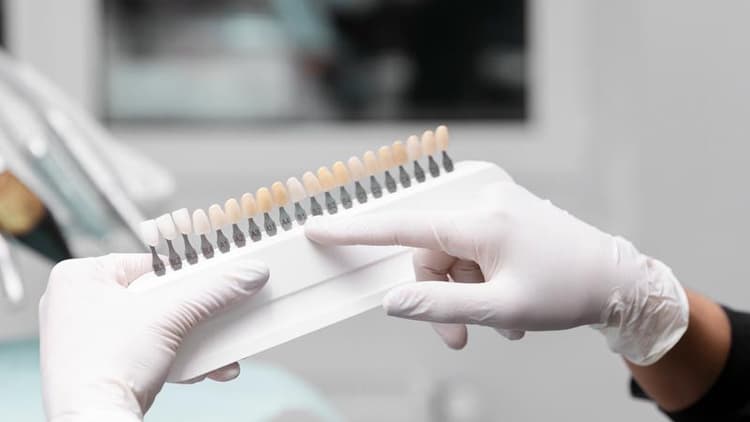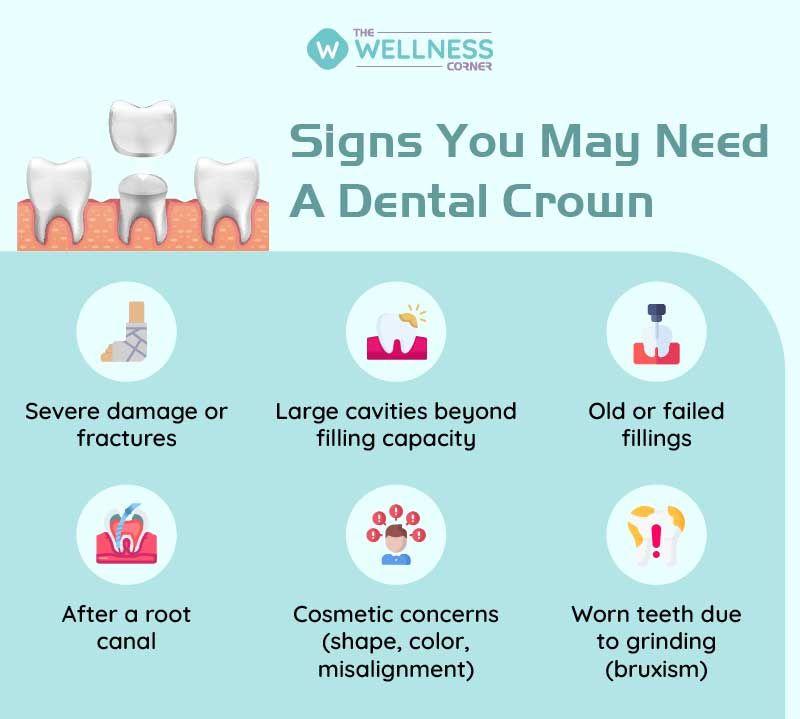Signs You Might Need A Dental Crown—And What To Do Next?
3 months ago
5 minute read.

People notice your smile first, so maintaining your dental health is essential for not just cosmetic purposes, but also your overall health. Putting in the effort of brushing, flossing, and visiting the dentist regularly does a lot to maintain your dental hygiene, but when it comes to maintaining the health of your teeth, there are things we can't avoid.
Dental crowns are one of several good options for restoring teeth that are damaged or otherwise compromised, but how will you know if you need a dental crown? Recognizing signs of trouble and proceeding with treatment may eliminate the risk of more serious problems in the future.
This article outlines some common signs, the process to place a crown, and what you should do if you believe you may need this critical restoration for your teeth.
Also Check: Tips To Overcome Tooth Ache
Understanding Dental Crowns: More than Just a Cap
A dental crown (often referred to as a cap) is a dental restoration in the shape of a tooth that fits over the visible portion of an irreparably damaged tooth above the gum line.
Modern dental crown procedures have evolved significantly, offering comfortable treatment experiences and excellent outcomes. Dental crowns will protect and restore the entire tooth instead of merely filling a small cavity, thus allowing for greater structural restoration whilst offering considerable protection from further damage.
Crowns today are commonly made from porcelain, ceramic, metal alloys, or a combination of materials. In many cases, though, the preliminary decision as to which material will be utilized is instead based upon your bite pattern, tooth location, aesthetics, and finally, cost basis.
Porcelain and ceramic crowns are aesthetically very compatible and ideal for anterior teeth.
Metal crowns yield better protection for posterior teeth (in terms of durability when chewing).
Also Read: How To Manage Your Tooth Cavity Pain?

Critical Warning Signs That Signal Crown Necessity
Severe Tooth Damage and Fractures
There is no question that one of the clearest signals for a crown is when a tooth is broken or damaged beyond basic filling repair. If you have a fractured tooth, particularly if it is below the gum or has several surfaces affected, then you need the protection that a crown can offer. Even hairline fractures can grow over time, and if left untreated, they may become structurally significant enough to necessitate tooth removal.
If you notice cracks, chips, or breaks in your teeth, especially after an injury, a fall, or consuming a complex piece of food, consult your dentist for an evaluation. What looks like a minor blemish on the tooth surface may also indicate greater structural tooth issues that require a crown restoration.
Extensive Decay beyond Filling Capacity
When decay in a tooth is so extensive that traditional fillings are not sufficient, the next step is to restore function and seal out further decay with a crown. Large cavities can compromise a considerable percentage of the tooth structure, rendering it incapable of supporting traditional restoratives—even if the remainder is essentially healthy tooth structure.
Your dentist will look at the ratio of healthy tooth structure to decay. If the decay has affected a larger portion of the tooth, such as forty percent or more of the tooth structure, or the cavity involves several surfaces, in all probability the best long-term predictable solution will be a crown.
Failed or Inadequate Previous Restorations
Teeth with large, older fillings that have either failed or started to leak may need a crown. The filling materials expand and contract over time and may create an open space between the restoration and the natural tooth structure, allowing bacteria to infiltrate and cause secondary decay.
Furthermore, teeth with multiple fillings may be so structurally compromised that there is insufficient remaining natural tooth structure to support another conventional restoration. Crowns allow for enough structural support to preserve the tooth long term.
Root Canal Treatment Requirements
Teeth that are treated with root canal therapy will almost always need a crown afterwards. The root canal procedure involves the removal of the nerve and blood supply, which means that the remaining structure of the tooth is more brittle than before and prone to fracture.
If the tooth is not crowned to protect it, the chances of catastrophic failure are substantial. Even if a tooth that has been treated with a root canal feels perfectly fine at this point, the lack of internal moisture and internal structure should place any careful and educated dentist on notice to occlude and protect the tooth with a crown for greater long-term success.
Cosmetic Concerns and Aesthetic Issues
If teeth are substantially discolored, poorly shaped, or misaligned, a crown may be done solely for aesthetic reasons. Unlike teeth whitening, which can correct surface staining, a crown may restore the aesthetic appearance of problematic teeth.
Crowns can be a solution for:
- Teeth with intrinsic staining that has not responded to whitening treatment.
- Congenital disabilities of shape or size.
- Slight positioning issues that don't require formal orthodontics.
Also Read: Five Foods That Can Stain Your Teeth
Excessive Wear and Grinding Damage
Bruxism (teeth grinding) can ultimately erode tooth surfaces in time. Severely worn teeth may require crowns to restore the bite relationship and protect against additional wear.
Physical Symptoms to Consider
Unyielding Pain and Sensitivity
While not all tooth pain is an indicator for a dental crown, persistent pain may represent different problems that could require complete restoration, otherwise known as dental crowns for fixing your tooth.
Sharp pain when biting down on something may indicate a crack or fracture.
Temperature sensitivity that persists (over days, weeks, or more) may indicate nerve issues requiring root canal therapy and a crown.
Changes in Bite or Chewing Patterns
If you have found you're unconsciously avoiding chewing on certain teeth or that your bite feels "off," it may be related to structural problems of those teeth. Worn or damaged teeth can alter your natural bite and lead to jaw joint issues if left untreated.
The Crown Restoration Process: What to Expect
Understanding what to expect with the dental crown process can reduce your stress and help you prepare for any treatment. Usually, the process requires two to three appointments, but many offices now offer same-day crowns with new digital technology.
First Appointment
- Dentist examines the tooth (digital imaging may be used).
- Local anesthesia is applied.
- Damaged tooth structure is removed and reshaped.
- Impressions or scans are taken.
- A temporary crown is fabricated.
Laboratory Fabrication
- The final restoration is made at a dental lab.
- This process typically takes 1–2 weeks.
Final Appointment
- Temporary crown is removed.
- Dentist checks fit, bite, and appearance of the crown.
- Crown is permanently cemented.
Must Read: Tooth Brushing- The Right Way!
Taking Action: Your Next Steps
Instant Assessment and Consultation
If you have seen one or more of the previous symptoms, please call and book a complete dental assessment as soon as possible. Very often, early intervention allows for more conservative dental care, which tends to lead to a better overall outcome. Do not wait until you are in pain; pain typically means the problem is bigger and will usually require a more complex treatment plan.
At the consultation, always share with the dentist your symptoms, concerns, and desired outcomes for treatment. Do not hesitate to ask questions regarding the types of crown material offered, expected lifespan, and maintenance of the different types of crowns.
Treatment and Planning
When your dentist recommends a crown, they and their dental team will develop a treatment plan that may include treating any existing gum disease, root canal therapy, and the material type for the different crowns.
You will also need to consider:
- Your insurance coverage and out-of-pocket expenses.
- How treatment scheduling aligns with your personal needs.
- Whether the practice offers payment or financing plans.
Preventive Care is Key to Your Future Success
Once you have completed the necessary crown treatment and preventive care recommendations, taking advantage of regular preventive care and modifying your lifestyle is the best way to preserve your crowns for life!
- Attend regular dental visits to detect early crown or tooth problems.
- Get scaling and cleaning every 6 months to minimize plaque and tartar.
- Consider a custom night guard if you grind your teeth.
Leave a Comment
Related Articles
Health Checks @ Home
Service
Explore
© 2025 Truworth Health Technologies Pvt. Ltd.




